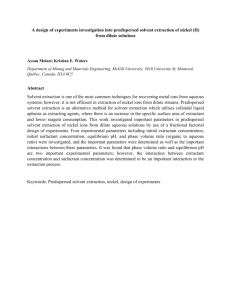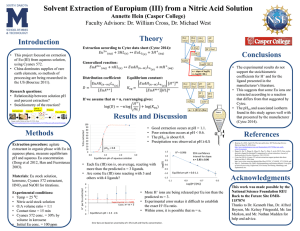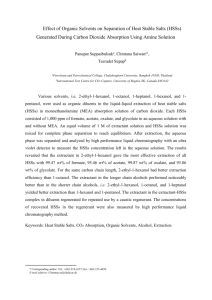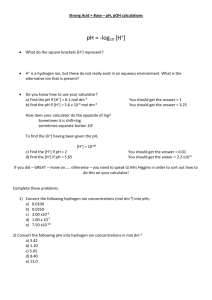Solvent Extraction and Separation of Al(III) and Ni(II) from aqueous
advertisement
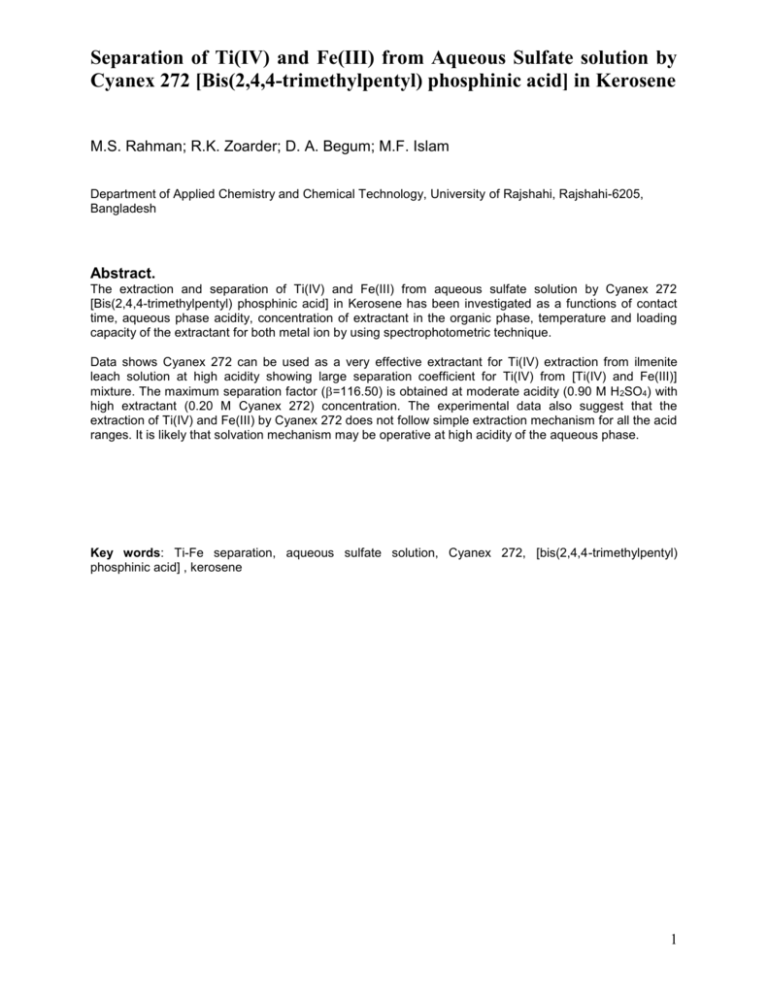
Separation of Ti(IV) and Fe(III) from Aqueous Sulfate solution by Cyanex 272 [Bis(2,4,4-trimethylpentyl) phosphinic acid] in Kerosene M.S. Rahman; R.K. Zoarder; D. A. Begum; M.F. Islam Department of Applied Chemistry and Chemical Technology, University of Rajshahi, Rajshahi-6205, Bangladesh Abstract. The extraction and separation of Ti(IV) and Fe(III) from aqueous sulfate solution by Cyanex 272 [Bis(2,4,4-trimethylpentyl) phosphinic acid] in Kerosene has been investigated as a functions of contact time, aqueous phase acidity, concentration of extractant in the organic phase, temperature and loading capacity of the extractant for both metal ion by using spectrophotometric technique. Data shows Cyanex 272 can be used as a very effective extractant for Ti(IV) extraction from ilmenite leach solution at high acidity showing large separation coefficient for Ti(IV) from [Ti(IV) and Fe(III)] mixture. The maximum separation factor (=116.50) is obtained at moderate acidity (0.90 M H 2SO4) with high extractant (0.20 M Cyanex 272) concentration. The experimental data also suggest that the extraction of Ti(IV) and Fe(III) by Cyanex 272 does not follow simple extraction mechanism for all the acid ranges. It is likely that solvation mechanism may be operative at high acidity of the aqueous phase. Key words: Ti-Fe separation, aqueous sulfate solution, Cyanex 272, [bis(2,4,4-trimethylpentyl) phosphinic acid] , kerosene 1 Introduction: The extractant Cyanex 272 is a propietary but technical grade item of Cytec Canada Inc. (CYTEC). Its active component is bis[2,4,4-trimethylpentyl) phosphinic acid. The structure of Cyanex-272 is as follows- O R P R OH R= CH3 CH3 CH3 C CH2 CH CH2 CH3 This technical grade extractant has been used since 1983 and found to be very effective for the extractive separation of Co(II) from Ni(II). [Preston, 1983; Danesi et al., 1984; Rickelton et al., 1984; Xun and Golding 1987; Chou and Beekstead, 1990; Rickelton et al., 1991; Gandhi et al., 1993; Tait and Brain, 1993] However other metal ion pairs have been investigated for separation such as,Co(II)/Cu(II),Cu(II)/Zn(II), Th(IV)/Fe(III)/Lu(II), Zn(II)/Cd(II), Mn(II)/Zn(II), Co(II)/Ni(II), Fe(III)/Cd(II)/Ni(II) and Al(III)/Ni(II) [Sole and Hiskey, 1991; Cao. et al., 1992;Wang and Li, 1994; Zou et al., 1994 ; Devi et al 1997., Reddy and Sarma 2001,. Pilar et al., 2001. Islam and Rahman, 2006 etc] There seems to be no report on Ti(IV)/Fe(III) separation by Cyanex 272. However, the separation using carboxylic acids and di2-ethylhexyl phosphoric acid has been attempted in the past. Al(III) and Ni(II) separation has also been tried by tolyl phosphate by using NH3 medium in presence of fluoride ions (Islam and Mostafa,1995). The extraction and separation of titanium and iron by carboxylic acids, carbolic acid and carpic acid (Islam et al., 1988) is very low. Though the reports on bis (2-ethylhexyl) phosphoric acid (Islam et al., 1979) was satisfactory, the complete removed of iron was not achieved in a single operation. There are numerous reports on the extraction, separation and study of mechanism of different metal ions by Cyanex 301, Cyanex 302 Cyanex 471 and Cyanex 923. The present work reports about the extractive behavior of titanium and iron as well as separation from their mixture by Cyanex 272, as most of the titanium ores is associated with iron. Materials and Methods: Standard solution of Ti(IV) was prepared by fusing 0.5 g of analytically pure TiO 2 with 10.0 g of KHSO4 in a suitable platinum crucible with heating until the oxide is dissolved. It was cooled and dissolved in 15% H2SO4 by gentle heating and diluted to 500 cm 3 by 15% H2SO4 acid. Another stock solution of Fe(III) was prepared by dissolving exactly 0.864 g of A.R grade ferric ammonium sulfate in some distilled water and to it 10 cm3 conc. H2SO4 was added. The resulting solution was then diluted to 1000 cm 3 and mixed thoroughly. The solutions were standardized by methods given below. The extractant Cyanex 272 having 85% purity was used without further purification. All other chemicals were of reagent grade and used without further purification. The diluent, kerosene, was purchased from the local market and distilled to collect the colorless fraction obtained in the range of 200-260°C. A stock solution of Cyanex 272 (1 M) was prepared by weighing out exactly 290 g of Cyanex 272 in a 1 L volumetric flask and diluting by distilled kerosene. Extractant solutions of different concentrations were prepared by proper dilution of these stock solutions by distilled Kerosene. A definite aliquot of an aqueous phase 20 ml was taken in a 125 ml reagent bottle and to it same aliquot of organic phase 20 ml was added. The bottle was stoppered and shaken vigorously for a definite time period in a thermostatic water bath at 30°C (otherwise stated in the phase contact study). After attainment of equilibrium, the phases were allowed to settle and disengaged. The aqueous phase was used to measure the metal ion content. The equilibrium organic phase metal ion concentrations were estimated by the method of difference. The distribution ratio (D) of a metal ion was calculated as the ratio of metal ion concentration in the organic phase to that in the aqueous phase at equilibrium. In the case of loading test, the organic phase was repeatedly contacted with fresh equal volume of aqueous solutions until the saturation of the organic phase with the metal was attained. Metal contents [Ti(IV) and Fe(III)] in the 2 aqueous phase was estimated by the hydrogen peroxide colorimetric method at λ=410 nm for Ti(IV) (Vogel, 1989) and the thiocyanate method at λ=480 nm for Fe(III) (Vogel, 1989) using spectrophotometer ANA-75 (Tokyo Photoeletric Company, Japan). Results and Discussion: 1. Effect of phase–contact time. The Fig-1, represents contact time in minutes and the distribution ratio. It is evident from the figure that the extraction ratio of Ti(IV) and Fe(III) increases continuously with the contact time. Near the equilibrium point the increase of extraction ratio with respect to time is much slower. No appreciable extraction of Ti(IV) and Fe(III) takes places after 35 and 18 minutes respectively. Therefore, it is concluded that the equilibrium is reached at 40 minutes for Ti(IV) and at 20 minutes for Fe(III) and after that the curves leveled off for 0.10 M Cyanex 272 concentration.. Thus in subsequent experiments, 40 minutes mixing have been used to ensure equilibrium for both aqueous [Ti(IV) and Fe(III)] mixture. 2.0 logD Ti(IV)/Fe(III) 1.6 1.2 0.8 0.4 0.0 0 10 20 30 40 50 60 Contact time (minutes) Fig.-1: Effect of contact time to reach equilibrium Ti(IV) and Fe(III) Initial [Ti(IV)] = 1.1 gm dm-3, Acidity = 0.60 mol dm-3 H2SO4, 0.1 M Cyanex 272 , Initial [Fe(III)] = 1.1 gm dm-3, Acidity = 0.005 mol dm-3 H2SO4, 0.1 M Cyanex 272 2. Effect of extraction of Ti(IV) and Fe(III) from [ Ti(IV) and Fe(III)] mixture on aqueous phase acidity. The data are plotted as log D vs. log [H2SO4] in Fig.-2 & 3. This figure represents the variation of distribution ratio on its aqueous phase acidity. The plot shows that the extraction is decreased with increasing aqueous phase acidity both for Ti(IV) and Fe(III) extraction within the range of 0.25 to 0.90 M H2SO4.The extraction of Ti(IV) is higher than that of Fe(III).About 95% Ti(IV) is extracted at 0.25 M H2SO4 with 0.20 M Cyanex 272 and about 24% of Fe(III) is extracted with the same condition which indicates that comparatively larger separation of the metal ions [Ti(IV)and Fe(III)] is possible at higher acidity under this investigation. The extraction of Ti(IV) and Fe(III) is more with 0.20 M Cyanex 272 than with 0.05 M Cyanex 272 extractant. At 0.90 M, the extraction rate of Fe(III) is very poor which is about 1.82 % and almost similar with different extractant concentration (0.05, 0.10, 0.15 and 0.20 M Cyanex 272) and for 0.60 M H2SO4, the extraction rate of Fe(III) are also same with extractant concentration ( 0.10, 0.15 and 0.20 M Cyanex 272). 3 0.0 1.2 -0.4 logD Fe(III) logD Ti(IV) 1.6 0.8 0.4 0.0 -1.2 -1.6 -0.4 -0.8 -0.7 -0.8 -0.5 -0.3 -0.1 0.1 -2.0 -0.7 -0.5 -0.3 -0.1 0.1 log [H2SO4] log [H2SO4] Fig.-2: Effect of extraction of Ti(IV) from Ti(IV) and Fe(III) mixture on aqueous phase acidity. Fig.-3: Effect of extraction of Fe(III) from Ti(IV) and Fe(III) mixture on aqueous phase acidity. [Ti(IV)]: [Fe(III)] = 1:1; initial [Ti(IV)] = 1.1 gm dm -3, Temperature = (301)C; Contact time = 40 minutes; Phase ratio, A/O = 1:1; 0.05 M Cyanex 272; Slope = 1.24; 0.10 M Cyanex 272; Slope = 1.58; 0.15 M Cyanex 272; Slope = 1.50; 0.20 M Cyanex 272; Slope = 1.57 [Ti(IV)]: [Fe(III)] = 1:1; initial [Ti(IV)] = 1.1 gm dm-3, Temperature = (301)C; Contact time = 40 minutes; Phase ratio, A/O = 1:1; 0.05 M Cyanex 272; Slope = 1.29; 0.10 M Cyanex 272; Slope = 1.72; 0.15 M Cyanex 272; Slope = 1.94; 0.20 M Cyanex 272; Slope = 2.15 In the case of low aqueous acidity the extractant molecule ionize in the aqueous phase boundary liberating hydrogen ion or its ionizing tendency becomes predominant, forming a neutral extractable species in which the polar phosphoryl oxygen atom may satisfy the co-ordination number of the metal cation. Lower is the aqueous acidity, higher is the ionization or metal cation replacement; and thus more is the extraction. In a highly acidic solution the above tendency is suppressed due to common ion effect, as a result the exchange of metal cation with hydrogen ion of the extractant becomes difficult and extraction is decreased. At a very high acidic solution no ionization of the extractant occurs at all and it behaves like a neutral phosphate ester. In such a case, if any extraction occurs, the solvation by the extractant becomes the principal governing factor. The distribution ratio is decreased with the increase of hydrogen ion concentration in the aqueous phase (peppard et al. 1962). It is observed that the distribution ratio of both Ti(IV) and Fe(III) increases with the increase of extractant concentration. In the case of Ti(IV) extraction, the slopes of acid dependence curved are 1.24, 1.58, 1.50,and 1.57 with the extractant concentration (0.05, 0.10, 0.15 and 0.20 M Cyanex 272) respectively and in case of Fe(III) extraction the acid dependence slopes are 1.29, 1.72, 1.94,and 2.15 with the extractant concentration (0.05, 0.10, 0.15 and 0.20 M Cyanex 272) respectively. These are much lower than theoretical 3 as discussed below. 3. Effect of extraction of Ti(IV) and Fe(III) from [ Ti(IV) and Fe(III)] mixture on extractant concentration. The Fig.-4 & 5 represents the variation of distributions ratio of Ti(IV) and Fe(III) on extractant concentration. It is seen that the extraction of Ti(IV) increases linearly with the increase of extractant concentration. The slopes of the lines in this figure are 1.50, 1.31, 1.30 and 1.20 for the aqueous phase acidities 0.25, 0.46, 0.60 and 0.90 M H2SO4 respectively. In the case of Fe(III) at low acidities 0.25, 0.46,and 0.60 M H2SO4 the extraction of Fe(III) increases linearly with the increase of extractant concentration. The slopes of the lines in this figure are 0.73, 0.42 and 0.15 for the aqueous phase acidities 0.25, 0.46 and 0.60 M H2SO4 respectively. On the contrary, at 0.90 M H2SO4, the extraction of Fe(III) is constant with different extractant concentrations and distribution ratio is very low or constant for 0.10, 0.15 and 0.20 M Cyanex 272 concentration, in other words the extraction does not increase with the extractant concentration but with 0.50 M Cyanex 272 is much lower than with extractant concentration of 0.20 M Cyanex 272. The extraction of Fe(III) by Cyanex 272 is also interesting. The slope decreases with increasing acidity. The maximum slope obtained in the acidity range studied is 0.72, which is much less than the theoretical value as given by the general equationFe+3+3[HA] = Fe+3[HA]3 +3H+....................................................(I) (HA= Monomer of Cyanex 272) Where extractant dependence of 3 and inverse hydrogen ion dependency of 3 is suggested. The experimental low values of extractant and hydrogen ion dependency suggests that the TiO 2+ extraction, 4 1.6 0.0 1.2 -0.4 0.8 logD Fe(III) logD Ti(IV) The Fe(III) does not follow the simple extraction mechanism for all the acid ranges. It is likely that solvation mechanism may be operative at high acidity of the aqueous phase. 0.4 0.0 -1.2 -1.6 -0.4 -0.8 -1.4 -1.2 -1 -0.8 -2.0 -1.5 -0.6 log [Cyanex 272] Fig.-4: -0.8 Effect of extraction of Ti(IV) from Ti(IV) and Fe(III) mixture on extractant concentration. [Ti(IV)] : [Fe(III)] = 1:1; Initial aqueous phase, [Ti(IV) = 1.1 gm dm-3; Contact time = 40 minutes; Phase ratio, A/O = 1:1; Temperature = (30 1) C; 0.25 mol dm-3 H2SO4; Slope = 1.50; 0.46 mol dm-3 H2SO4; Slope = 1.31; 0.60 mol dm-3 H2SO4; Slope = 1.30; 0.90 mol dm-3 H2SO4; Slope = 1.20 -1.25 -1 -0.75 -0.5 log [Cyanex 272] Fig.-5: Effect of extraction of Fe(III) from Ti(IV) and Fe(III) mixture on extractant concentration. [Ti(IV)] : [Fe(III)] = 1:1; Initial aqueous phase, [Ti(IV) = 1.1 gm dm -3; Contact time = 40 minutes; Phase ratio, A/O = 1:1; Temperature = (30 1) C; 0.25 mol dm-3 H2SO4; Slope = 0.73; 0.46 mol dm3 H2SO4; Slope = 0.42; 0.60 mol dm-3 H2SO4; Slope = 0.15; 0.90 mol dm-3 H2SO4; Slope = 0.00 4. Effect of extraction of Ti(IV) and Fe(III) from [ Ti(IV) and Fe(III)] mixture on temperature. The Fig.-6 & 7 represent log D vs. inverse of absolute temperature, showing the variation of distribution ratio on temperature. It is seen that the extraction of Ti(IV) increases linearly with the increase of temperature at all acidities. On the contrary, the extraction of Fe(III) at different acidities show different extraction behavior. At acidity 0.46 M H2SO4, the extraction rate increases with the increase of temperature up to 400C and then decreased with the increase of temperature. At acidities 0.60 and 0.90 M H2SO4 concentration, the extraction of Fe(III) increases with the increase of temperature and at 50 0C it is maximum for these two acidities and then the extraction is decreased with the increase of temperature. The extraction becomes equal at 600C for all three acidities. The lower extraction above 500C at acidities 0.60 and 0.90 M H2SO4 may be explained on the basis of the formation inextractable hydrolyzed Fe(III) with the increase of temperature. The slope of the lines has been calculated by Vant-Hoff equation giving the average enthalpy change (H) as 5.34 k cal mol-1 for Ti(IV) and 20.14 k cal mol-1 for Fe(III) for the portion at which the distribution ratio increases with the increase of temperature. The extraction of Ti(IV) is endothermic up to 600C and Fe(III) extraction is also endothermic process up to 500C by 0.10 M Cyanex 272.Thus extraction of Ti(IV) and Fe(III) by 0.10 Cyanex 272 in kerosene system is strongly influenced by temperature. 5 -0.4 0.6 -0.6 -0.8 logD Fe(III) logD Ti(IV) 0.8 0.4 0.2 0.0 -1.0 -1.2 -1.4 -0.2 -1.6 -0.4 -1.8 2.9 3 3.1 3.2 3.3 3.4 2.9 3 3 3.2 3.3 3.4 3 1/T °A × 10 Fig.-6: 3.1 1/T °A × 10 Effect of extraction of Ti(IV) from Ti(IV) and Fe(III) mixture on temperature. [Ti(IV)] : [Fe(III)] = 1:1; Initial aqueous phase, [Ti(IV) = 1.1 gm dm-3; Extractant = 0.1 mol dm-3 Cyanex 272 in kerosene; Contact time = 40 minutes; Phase ratio, A/O = 1:1; Temperature = (30 1) C; 0.46 mol dm-3 H2SO4; Slope = -1.03; 0.60 mol dm-3 H2SO4; Slope = 0.85; 0.90 mol dm-3 H2SO4; Slope = -1.62 Fig.-7: Effect of extraction of Fe(III) from Ti(IV) and Fe(III) mixture on temperature. [Ti(IV)] : [Fe(III)] = 1:1; Initial aqueous phase, [Ti(IV) = 1.1 gm dm-3; Extractant = 0.1 M Cyanex 272 in kerosene; Contact time = 40 minutes; Phase ratio, A/O = 1:1; Temperature = (30 1) C; 0.46 mol dm-3 H2SO4; 0.60 mol dm-3 H2SO4; Slope = -3.4; 0.90 mol dm-3 H2SO4; Slope = -5.4 5. Loading capacity of Cyanex 272 for Ti(IV) and Fe(III). Total cumulative Ti(IV)/Fe(II I) gmdm -3 The loading capacity is defined as the amount of metal content in grams extracted per 100 g of pure extractant. It is an important factor for the study of mechanism of extraction and also for the industrial evaluation of the extractant. High values of loading capacity are desirable for any particular extractant metal system for industrial applications. 20.0 15.0 10.0 5.0 0.0 0 2.5 5 7.5 10 12.5 15 Contact number Fig.-8: Effect of loading of organic phase in the extraction of Ti(IV)/Fe(III). Contact time = 40 minutes; Temperature = (301)C; Acidity = 0.32 mol dm-3 H2SO4 Ti(IV): 0.40 M Cyanex 272; 0.20 M Cyanex 272; Fe(III): 0.40 M Cyanex 272; 0.20 M Cyanex 272 The organic phases 20 ml was repeatedly contacted for 40 min at 300C with the fresh equal volume of aqueous solution containing fixed concentration of metal ions [3.50 gm dm-3 Ti(IV) and 2.0 gm dm -3 Fe(III) mixture with 0.32 M H2SO4]. After equilibration, the phases were disengaged and the aqueous phases were analyzed for Ti(IV) and Fe(III) contents. The amount of metal ions [Ti(IV) and Fe(III)] transferred into the organic phase for each contact was then determined by difference from initial aqueous concentration 6 and the cumulative concentration of Ti(IV) and Fe(III) in the organic phase after each stage of contact was estimated. The cumulative [(Ti(IV)/Fe(III)] g dm-3 vs. contact number plot is given in Fig- 8. In this figure, it is seen that the organic phase is saturated with Ti(IV) after 9 th contact. The organic phase is saturated with Fe(III) after 13th contact for the experimental condition stated [3.50 gm dm -3 Ti(IV),0.32 M H2SO4 and 0.40 M Cyanex 272]. The loading capacity for Ti(IV) is 18 g dm-3 and 3.65 g dm-3 for Fe(III) at 0.32 M H2SO4 and 0.40 M Cyanex 272 concentration and about 7.70 g dm-3 of Ti(IV) and 3.64 g dm-3 of Fe(III) for 0.32 mol dm-3 H2SO4 and 0.20 M Cyanex 272 concentration. It is observed that the maximum loading of Cyanex 272 for Fe(III) is almost same for both 0.40 and 0.20 M Cyanex 272.Therefore, 0.20 M Cyanex 272 is satisfactory for Fe(III) loading of Cyanex 272. Loading data indicates Ti(IV) : Cyanex-272 ratio is 1:1.25 and Fe(III) : Cyanex 272 ratio is 1:2.86 at 0.20 M Cyanex 272, indicating almost 1:1 metal complexes in the organic phase. Separations study: 1. Effect of aqueous phase acidity and extractant concentration on separation factor. The separation factor () for [Ti(IV) and Fe(III)] system has been calculated for each extractant concentration for 0.05, 0.10, 0.15 and 0.20 M Cyanex 272.It is seen from the plots (Fig.9) that the separation factor increases with the increase of aqueous phase acidities at all concentration of Cyanex 272. As the acidity increases the separation factor differs for different extractant concentration in the following sequences: 0.20 M 0.15 M 0.10 M 0.05 M Cyanex 272.The maximum separation factor is noted for extraction with 0.20 M Cyanex 272 from highly acidic (0.90 M H2SO4 ) [Ti(IV) and Fe(III)] mixed (1:1) solution. Separation factor(Ti/Fe) It is concluded that the maximum separation factor for [Ti(IV) - Fe(III)] system is achieved at high aqueous acidity with high extractant concentration (0.20 M Cyanex 272). 120 100 80 60 40 20 0 0 0.1 0.2 0.3 0.4 0.5 0.6 0.7 0.8 0.9 1 [H2SO4] mol dm-3 Fig. 9: Effect of aqueous phase acidity on separation. [Ti(IV)] : [Fe(III)] = 1:1; Initial aqueous phase=1.1 g, dm-3, [Ti(IV) and 1.1 gm dm-3 Fe(III); Extractant = 0.1 M Cyanex 272 in kerosene; phase ration, A/O = 1:1 Contact time = 40 minutes; Temperature = (291)C; 0.05M Cyanex 272; 0.10 M Cyanex 272; 0.15 M Cyanex 272; 0.20 M Cyanex 272 2. Effect of temperature of extraction separation factor. The separation factor () at acidities 0.46, 0.60 and 0.90 M is graphically represented as function of temperature (Fig.10). In all the cases the separation factor decreases with the increase of temperature 7 then it is increased again with the increase of temperature. Maximum separation factor is obtained at lower aqueous acidity and higher temperature. The separation factor increases in the following order: 0.46 M 0.60 M 0.90 M H2SO4 at 0.01 M Cyanex 272.Thus the separation factor () is markedly temperature dependent. From the plots we may conclude that, a) Ti(IV) can be separated from Fe(III) at all (0.46, 0.60 and 0.90 M H2SO4 ) acidities. b). The maximum separation of Ti(IV) from Fe(III) is possible at Separation factor, (Ti/Fe) 600C with 0.46 M Cyanex 272 concentration. 60 50 40 30 20 10 0 25 30 35 40 45 50 [H2SO4] mol dm 55 60 65 -3 Fig. 10: Effect of temperature on separation factor () [Ti(IV)] : [Fe(III)] = 1:1; Initial aqueous phase = 1.1 gm dm -3 Ti(IV) and 1.1 gm dm-3 Fe(III); Phase ratio, A/O = 1:1; Contact time = 40 minutes; 0.46 mol dm-3 H2SO4; 0.60 mol dm-3 H2SO4; 0.90 mol dm-3 H2SO4 Conclusions: Cyanex 272 is a very effective extractant for the extraction and separation of Ti(IV) and Fe(III) from an aqueous sulfate solution containing [Ti(IV) and Fe(III)]. The equilibrium is reached within 40 min for Ti(IV) and 20 min for Fe(III).The loading capacity of Ti(IV) and Fe(III) are 18 gm/L and 3.65 gm/L respectively for 0.40 M Cyanex 272 and 0.32 M H2SO4 concentration. Separation factor () of Fe(III) with respect to Ti(IV) is 116.50 at the experimental conditions [temperature = (30 1)C, extractant concentration = 0.20 M Cyanex-272 in kerosene, phase ratio = 1:1, 0.90 M H2SO4], suggesting good separation from titanium. The positive H value suggests that the extraction process is endothermic in nature and the average enthalpy change (H) values are 5.34 and 20.14 k cal mol-1 for Ti(IV) and Fe(III) respectively for 0.10 M Cyanex 272. From the temperature dependence mechanism it is shown that Ti(IV)/Fe(III) is strongly influenced by temperature of extraction. References: Cao, Y., Goto, M. and Nakashio, F.1992. Extractive separation of Copper(II) and Zinc(II) using emulsion liquid membrene, Mo Kexue Yu Jishu 12(4), Pages 12-16. Chou, E.C., Beckstead, L.W.1990. Separation of nickel and cobalt from sulfate solution by solvent extraction US patent 4900522. 8 Danesi, P.R., Reichley-Yinger, I, Cianetti, C., Rickert, P.G.1984. Separation of cobalt and nickel by liquidliquid extraction and supported membranes with bis(2,4,4-trimethylpentyl) phosphinic acid (Cyanex-272 extractant) Solvent Extr. & Ion Exch., 2(6), Pages 781-814. Devi, N.B., Nathsarma, K.C. and Chakravortty, V. 1997 Extraction and separation of Mn(II) and Zn(II) from sulfate solutions by sodium salts of Cyanex 272. Hydrometallurgy, 45(1-2). Pages 169-179 Gandhi, M.N., Deorkar, N.V.and Khopker, S.M.1993. Solvent extraction separation of cobalt(II) from nickel and other metals .Talanta, 40(10), Pages 1535-1539. Islam, M. F. and Rahman, M.S.2006. Solvent Extraction and Separation of Al(III) and Ni(II) from aqueous medium by Cyanex-272 in Kerosene. Pak.J. Sci. Ind. Res.49 (6) 395-399. Islam,F.,Mostafa,M.G.1995. Solvent extraction separation of Ni(II) and Al(III) by di-o-tolyl phosphoric acid from HF leach liquor of waste reforming nickel catalyst.J.Bangladesh Acad.Sci.19: 71-80. Islam, F.,Biswas, R.K.Manan,M.A.1988.J. Bang.Acad. Sci. 12(1), 99-105. Islam, F., Rahman, H., Ali, M., 1979. J. Inorg. Nucl.Chem.,41, 217-221. Peppard, .D.F. G. W. Mason, S. Mccarty and F.D. Johnson,1962. J. Inorg. Nucl. Chem., 24 ,321-332. Pilar Gonzalez, M., Saucedo, I., Navarro, R., Avila, M. and Guibal, E. 2001.Selective separation of Fe(III), Cd(II) and Ni(II) from dilute solutions using solvent-impregnated resins; Ind. Eng. Chem. Res., 40(25), Pages 6004-6013 Preston, J.S.1983. Recent developments in the separation of nickel and cobalt from sulfate solutions by solvent extraction, J. South Afr, Inst. Min. Metall, 83(6), Pages 126-132. Reddy, B.R. and Sarma, P.V.R.B. 2001. Separation and recovery of cobalt and nickel from sulfate solutions of Indian Ocean nodules using Cyanex 272. Miner. And Metall. Process., 18(3), Pages 172-176 Rickelton, W.A., Flett, D.S., West, D.W. 1984. Cobalt-nickel separation by solvent extraction with bis(2,4,4-trimethylpenlyl) phosphinic acid. Solvent Ext. Ion Exch. 2(6), Pages 815-838 Rickelton, W.A., Robertson, A.J. and Hill house, J.H.1991. The significance of diluent oxidation in cobaltnickel separation, A solvent Extr. Ion Exch., 9(1), Pages 73-84. Sole, K.C., Hiskey, J.B.1991. The potential for recovery of Cobalt from copper leach solutions. Proc. Copper 91- Cobre 91 Int. Symp. Hydrometallurgy and Electrometallurgy of Copper Canada, 3, Pages 229-243. Tait, Brian K.1993. Cobalt-nickel separation; the extraction of cobalt (II) and nickel (II) by Cyanex-301, Cyanex-302 and Cyanex-272. Hydrometallurgy, 32. No. 3, Pages 365-372. Vogel, A.I..1989. A text book of quantitative inorganic Analysis, 4th edition. Longman Scientific and Technical, London, UK PP 750. Vogel, A.I..1989. A text book of quantitative inorganic Analysis, 5th edition. Longman Scientific and Technical, London, UK PP 741-742. Wang, C., Li, D.1994. Extraction mechanism of Sc(III) and separation of Th(IV) Fe(III) and Lu(III) with bis(2,4,4-trimethylpentyl) phosphinic acid in n-hexane from sulphuric acid solution. Solvent Extr. & Ion Exch. 12(3), Pages 615-631. Xun F., Golding, J.A.1987. Solvent extraction of cobalt and nickel in bis(2,4,4-trimethylpentyl) phosphinic acid (Cyanex-272 extractant). Solvent Extr. & Ion Exch., 5(2), Pages 205-226. 9 10
